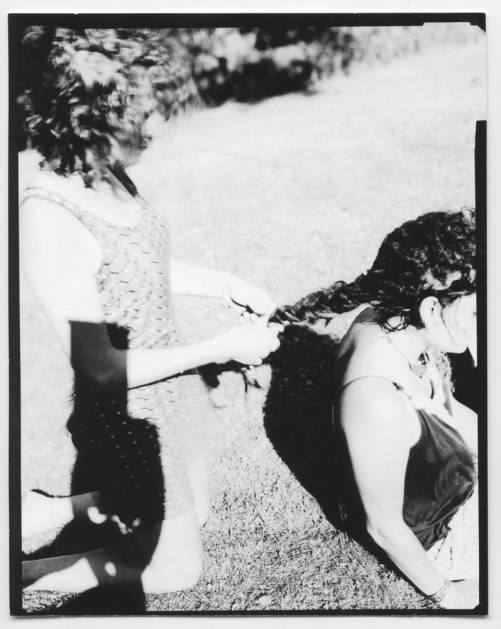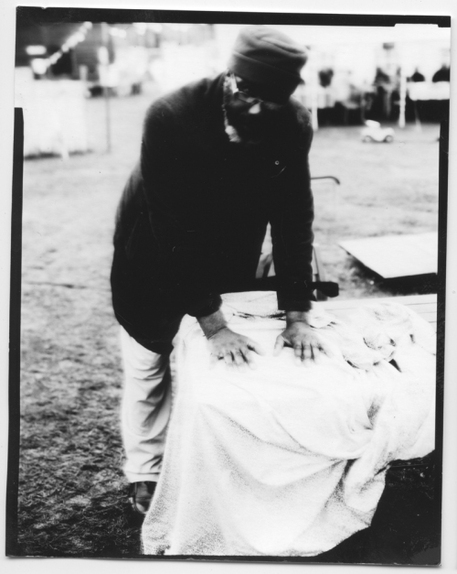Written by:
Philipp Schmickl
Share article:
Fourth day, August 4
The last two concerts of the last night I heard from far, they were loud enough. The next-to-last concert: Jonathan Larsson, dragspel; Oskar Reuter, guitar, nyckelharpa.
Last concert: Ständernas Svall – Finn Loxbo, guitar, singing; Vegard Lauvdal, drums.
I went to the bar and talked to the people. I got acquainted with Lucas Maia, a Brazilian from São Paulo who is living in Berlin and who, together with Léa Lanoë and Pierre Borel, is making a film, 16 mm, at the Hagenfesten. I talked to some volunteers and to some guests and I heard many stories, that are easily told to strangers. Justine told me, that she had heard from Mélody Justine who I told about my book-making and writing, that an écrivain (writer) is at the festival. She didn’t know how he looked liked, but judging from how I moved and looked, she thought it was me. So, I am identified and recognized as a writer. But am I really a writer?
The rain disregards any agenda
Under the stars
Howe Gelb
The instability of the cloudy. Today in the early afternoon I went to the gallery and saw Anna Högberg, saxophones; Susana Santos Silva, trumpet. The room was really bright compared to the general conditions. I sat down and closed my eyes until the end of the concert. I felt like being inside their instruments and I could have stayed longer. When I opened my eyes I saw two young elephants standing in front of me and I applauded.
It is half past three, 2016, I am 36 years old. The festival folks are speaking in different languages. Aimie has already opened the bar and put on Radio Nostalgie. Since days she didn’t remove her pink sun glasses which fits very well to her Moroccan face and her brazilian hairdo. She just stepped out of the bar and shouted, ‘The bar is open!’ and then she danced some steps in front of the entrance. Buenaonda. I am thinking about getting hold of a glass of rosé pettillant. with Itaru Oki
Later : Instead to the bar I went to the movies in the Ladan. The programme is curated by Pierre Borel and Léa Lanoë. This afternoon the films were accompanied by live music from Joel, Susana, Niklas, Linda, Antonin, Pierre-Antoine und Franziska, who were only introduced by their first names.
Voilà, the film-programme of the festival :
Mercredi 3/8
23H / Séance 1: Moullet/Smith
– Essai d’ouverture, de Luc Moullet – 14 ‘
– The Girl Chewing gum, de John Smith – 12′
– Gargantuan, de John Smith – 1′
– Barres, de Luc Moullet – 14′
– Associations, de John Smith – 7′
– Om, de John Smith – 4′
Jeudi 4/8
16H / Séance 2 : Jean Painlevé
–Le Bernard l’hermite, 14′
–La quatrième dimension, 10′
–Les amours de la pieuvre, 14′
–Le Vampire, 8′
01H / Séance 3 : Jean Rouch
–Cocorico Monsieur Poulet, de Jean Rouch – 92′
Vendredi 5/8
16H / Séance 4 : Ciné Konzert Bruce Lacey
– The Battle of New Orleans, 5′
– How to take a Bath 8′
– The Running and Stumbling and dumping Still, 10′
– The Kiss 8′
+ La Croissance des Végétaux, Institut Pasteur – 12′
01H / Séance 5 : Djibril Diop Mambety
– Badou Boy, de Djibril Diop Mambety – 56′
Samedi 6/8
16H / Séance 6 : 16mm
– Studie Zur Farbe, Lucas Maia, digital ton, 8′
– In the Traveller’s Heart, Distruktur, Optical ton, 20′
01H / Séance 7 :
–Dreaminimalist, de Marie Losier – 23′
–Germans taste the best , de Rosa von Praunheim – 26′
–Double Exposure, de Bruce Lacey – 3′
Léa and Pierre run the KK19. A space in Berlin for extraordinary musics, exhibitions, films, lectures, dancings, foods, and so forth, says the website. I have to visit them. With their choice of films, they pointed to a whole new world – there is so much that I don’t know and they added another dimension to that! Every film I saw during the festival I would watch again, but I don’t want to write about them. If I would, I would like to create a space wide as this text in order to show Connections and conditions but you know. What I want to say is that every festival that engages in experimenting, should provide a space for movies like on the list above. Live-accompanying is okay, but not necessary.
A man, an old Swede, is walking around the Hagen. He looks like Jean-François Pauvros with a radical haircut. (Unfortunately no photo).
A concert starts in the Stallet. I hope, I am going to hear it over to where I am sitting right now, still thinking of the two young elephants. Applause in the Stallet. Greta (three years old, fair-haired, like every Swedish child) is hiding from her mother (Franziska). I know where she is. Franziska does not.
The other child is wearing a mask upside down. In they kitchen dinner is being prepared. I can’t hear anything from the Stallet. The sun is shining on my black jacket.
Later : It was Martin Küchen, saxophones; Joel Bremer, violin who I finally went to listen to in the Stallet.
What is very frequent at the Hagen is a mixing of sounds, a mixing of the inside and the outside in the mind of the listener. The more quiet the concert, claro, the more you hear the sound of the surroundings. I thought : There is no will (and no possibility) to create an artificial/affectedly pureté (purity), ie to cut the music off from what is around. Thus, to let (in an anti-fascist manner) the mixing happen between music, humans, animals, machines, creaking wooden doors, le vent qui passe. One is relaxed and knows in what kind of world we live/love.
Half past eight, the sun is still shining. I am sitting by the river, most people are at the concert with Eva Rune, sång; Maria Misgeld, sång; Karin Ericsson Back, sång. Between the water and myself high grass and wild flowers are growing. Some mosquitos are circling round my ears. I will not write about every concert. I don’t have to say that much about music and I can’t listen to everything. And I won’t analyze any musical thing, but I will try to observe and find out what she does to people, what THIS music does to people and what effect she has on me. I am more interested in the relation between music and humans/societies than in the relation music to music or music to music history. I think like Andrew,
‘Really often, when the mind just wanders and lets the music do its thing, I mean, I keep coming back to really the primal things. (…) Because it’s really those things of life and death and food and animals and the stars and relationships with other people that I keep coming back to and then I think, those were the things that I’m thinking about in living, so of course those are the things that are going to come when I listen to the music.’ Andrew Choate, theoral no. 11

